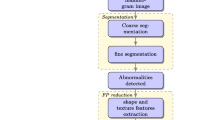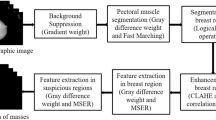Abstract
Screening helps to reduce mortality in the breast cancers. Mammography is a screening procedure used to detect breast cancer at an early stage. Computer-aided detection (CAD) systems can help in mammograms examination. Automatic differentiation between benign and malignant mammographic masses is a challenging task, due to high variability in mass structures. That is why, CAD systems frequently misdiagnose breast cancer. This paper presents a new CAD approach for mass detection in digital mammograms. The purpose of the proposed approach is to improve the discrimination between benign mass and malignant mass by reinforcing their statistics texture features. To achieve this aim, a new step based on super-resolution reconstruction is added to multistage CAD system. The proposed approach gives very good results comparing to other recent works. It achieves 96.7% classification accuracy using the MIAS (Mammography Image Analysis Society) dataset. This work shows that a super-resolution based approach improves the performance of the evaluated texture methods and thus outperforms benign/malignant mass classification for digital mammograms.




Similar content being viewed by others
Explore related subjects
Discover the latest articles, news and stories from top researchers in related subjects.References
Aboutalib SS, Mohamed AA, Berg WA, Zuley ML, Sumkin JH, Wu S (2018) Deep learning to distinguish recalled but benign mammography images in breast cancer screening. Am Assoc Cancer Res. https://doi.org/10.1158/1078-0432.CCR-18-1115
Baratloo A, Hosseini M, Negida A, El Ashal G (2015) Part 1: Simple definition and calculation of accuracy, sensitivity and specificity. Emergency 3:48–49
Bharathi PT, Subashini P (2013) Texture feature extraction of infrared river ice images using second order spatial statistics. Int J Comput Electr Autom Inf Eng 7:195–204
Braz JG, da Rocha, SV, de Almeida JDS, de Paival.AC, Silva AC, Gattass M (2018) Breast cancer detection in mammography using spatial diversity, geostatistics, and concave geometry. Multimed Tools Appl
Brem RF, Baum J, Lechner M, Kaplan S, Souders S, Naul LG, Hoffmeister J (2003) Improvement in sensitivity of screening mammography with computer-aided detection: a multiinstitutional trial. Am J Roentgenol 181:687–693
Chung J, Nagy JG (2008) Nonlinear least squares and super resolution. J Phys: Conf Ser. https://doi.org/10.1088/1742-6596/124/1/012019
Cole EB, Zhang Z, Marques HMR, Hendrick RE, Yaffe MJ, Pisano ED (2014) Impact of computer-aided detection systems on radiologist accuracy with digital mammography. Am J Roentgenol 203:909–916
Davis M (2015) Computer-aided detection fails to improve diagnostic accuracy of mammography. JAMA Intern Med
Doane DP, Lori ES (2011) Measuring skewness: a forgotten statistic? J Stat Educ 19:1–18
Duraisamy S, Emperumal S (2017) Computer-aided mammogram diagnosis system using deep learning convolutional fully complex-valued relaxation neural network classifier. IET Comput Vis 11:656–662
Farsiu S, Robinson MD, Elad M, Milanfar P (2004) Fast and robust multiframe super-resolution. IEEE Trans Image Process 13:1327–1344
Fenton JJ, Taplin SH, Carney PA, Abraham L, Sickles EA, D’Orsi C, Berns EA, Cutter G, Hendrick RE, Barlow WE, Elmore JG (2007) Influence of computer-aided detection on performance of screening mammography. N Engl J Med 356:1399–1409
Fenton JJ, Abraham L, Taplin SH, Geller BM, Carney PA, D’Orsi C, Elmore JG, Barlow WE (2011) Effectiveness of computer-aided detection in community mammography practice. J Natl Cancer Inst 103:1152–1161
Görgel P, Sertbas A, Uçan ON (2015) Computer-aided classification of breast masses in mammogram images based on spherical wavelet transform and support vector machines. Expert Syst 32:155–164
Hamoud M, Merouani HF, Laimeche L (2015) The power laws: Zipf and inverse Zipf for automated segmentation and classification of masses within mammograms. Evol Syst 6:209–227
Hardeep P, Swadas PB, Joshi M (2013) A survey on techniques and challenges in image super resolution reconstruction. Int J Comput Sci Mob Comput 2:317–325
Hedawoo M, Jaisawal A, Mehta N (2016) Comparison of data mining algorithms for mammogram classification. Int J Electr Electron Data Commun 4:31–34
Henriksen EL, Carlsen JF, Vejborg IM, Nielsen MB, Lauridsen CA (2018) The efficacy of using computer-aided detection (CAD) for detection of breast cancer in mammography screening: a systematic review. Acta Radiol. https://doi.org/10.1177/0284185118770917
Jehlol HB, Abdalrdha ZK, Oleiwi ASA (2015) Classification of mammography image using machine learning classifiers and texture features. Int J Innov Res Adv Eng 2:56–63
Khan A, Hussain M, Aboalsamh H, Mathkour H, Bebis G, Zakariah M (2016) Optimized Gabor features for mass classification in mammography. Appl Soft Comput 44:267–280
Kokkinos Y, Margaritis KG (2018) Kernel averaged gradient descent subtractive clustering for exemplar selection. Evol Syst 9:285–297
Kraus OZ, Ba JL, Frey BJ (2016) Classifying and segmenting microscopy images with deep multiple instance learning. Bioinformatics 32:i52–i59
Lehman CD, Wellman DR, Buist DSM, Kerlikowske K, Tosteson ANA, Miglioretti DL (2015) Diagnostic accuracy of digital screening mammography with and without computer-aided detection. JAMA Internal Med 175:1828–1837
Lévy D, Jain A (2016) Breast Mass classification from mammograms using deep convolutional neural networks. arXiv Preprint. arXiv:1612.00542
Liang W, Hu Y, Kasabov N (2015) Evolving personalized modeling system for integrated feature, neighborhood and parameter optimization utilizing gravitational search algorithm. Evol Syst 6:1–14
Lughofer E (2013) On-line assurance of interpretability criteria in evolving fuzzy systems—achievements, new concepts and open issues. Inf Sci 251:22–46
Mohanty AK, Beberta S, Lenka SK (2011) Classifying benign and malignant mass using GLCM and GLRLM based texture features from mammogram. Int J Eng Res Appl 1:687–693
Morton MJ, Whaley DH, Brandt KR, Amrami KK (2006) Screening mammograms: interpretation with computer-aided detection—prospective evaluation. Radiology 239:375–383
Nithya R, Santhi B (2017) Application of texture analysis method for mammogram density classification. J Instrum. https://doi.org/10.1088/1748-0221/12/07/P07009
Nocedal J, Wright S, (1999) Numerical optimization. Springer series in operations research
Nurhayati OD, Susanto A, Widodo TS, Tjokronagoro M (2011) Principal component analysis combined with first order statistical method for breast thermal images classification. Int J Comput Sci Telecommun 2:12–18
Oeffinger KC, Fontham ET, Etzioni R, Herzig A, Michaelson JS, Shih YC, Walter LC, Church TR, Flowers CR, LaMonte SJ, Wolf AM, DeSantis C, Lortet-Tieulent J, Andrews K, Manassaram-Baptiste D, Saslow D, Smith RA, Brawley OW, Wender R (2015) Breast cancer screening for women at average risk: 2015 guideline update from the American Cancer Society. JAMA 314:1599–1614
Padma P, Vijayalakshmi D (2016) Image retrieval using wavelet based interactive genetic algorithm. Int J Emerg Technol Adv Eng 6:178–183
Park SC, Min K, Park MK, Kang MG (2003) Super-resolution image reconstruction: a technical overview. IEEE Signal Process Mag 20:21-36
Pezeshki H, Rastgarpour M, Sharifi A, Yazdani S (2019) Extraction of spiculated parts of mammogram tumors to improve accuracy of classification. Multimed Tools Appl 78:19979–20003
Pise N, Kulkarni P (2017) Evolving learners’ behavior in data mining. Evol Syst 8:243–259
Rabidas R, Midya A, Chakraborty J, Arif W (2016) A study of different texture features based on local operator for benign-malignant mass classification. Int Conf Adv Comput Commun Proc Comput Sci Cochin India 93:389–395
Rangra K, Bansal KL (2014) Comparative Study of Data Mining Tools. Int J Adv Res Comput Sci Softw Eng 4:216–223
Ribli D, Horváth A, Unger Z, Pollner P, Csabai I (2018) Detecting and classifying lesions in mammograms with deep learning. Sci Rep 8:4165
Sachdeva J, Kumar V, Gupta I, Khandelwal N, Ahuja CK (2013) Segmentation, Feature extraction, and multiclass brain tumor classification. J Digit Imaging 26:1141–1150
Seryasat OR, Haddadnia J (2017) Assessment of a novel computer aided mass diagnosis system in mammograms. Biomed Res 28:3129–3135
Shastri AA, Tamrakar D, Ahuja K (2018) Density-wise two stage mammogram classification using texture exploiting descriptors. Expert Syst Appl 99:71–82
Sheba KU, Raj SG (2018) An approach for automatic lesion detection in mammograms. Cogent Eng. https://doi.org/10.1080/23311916.2018.1444320
Singh D, Singh M (2016) Classification of mammograms using support vector machine. Int J Signal Process Image Process Patt Recognit 9:259–268
Suzuki S, Zhang X, Homma N, Ichiji K, Sugita N, Kawasumi Y, Ishibashi T, Yoshizawa M (2016) Mass detection using deep convolutional neural network for mammographic computer-aided diagnosis. IEEE SICE; pp 1382–1386
Valarmathie P, Sivakrithika V, Dinakaran K (2016) Classification of mammogram masses using selected texture, shape and margin features with multilayer perceptron classifier. Biomed Res 310–314
Vincent P, Larochelle H, Lajoie I, Bengio Y, Manzagol PA (2010) Stacked denoising autoencoders: learning useful representations in a deep network with a local denoising criterion. J Mach Learn Res 11:3371–3408
Wang S, Rao VR, Chen P, Zhang Y, Liu A, Wei L (2017) Abnormal breast detection in mammogram images by feed-forward neural network trained by jaya algorithm. Fund Inf 151:191–211
Warren Burhenne LJ, Wood SA, D’Orsi CJ, Feig SA, Kopans DB, O’Shaughnessy KF, Sickles EA, Tabar L, Vyborny CJ, Castellino RA (2000) Potential contribution of computer-aided detection to the sensitivity of screening mammography. Radiology 215:554–562
Xie W, Li Y, Ma Yide (2015) Breast mass classification in digital mammography based on extreme learning machine. Neurocomputing 173:930–941
Zhang Y, Wang S, Liu G, Yang J (2016) Computer-aided diagnosis of abnormalbreasts in mammogram images byweighted-type fractional Fouriertransform. Adv Mech Eng 8:1–11
Zhang Y, Pan C, Chen X, Wang F (2018) Abnormal breast identification by nine-layer convolutional neural network with parametric rectified linear unit and rank-based stochastic pooling. J Comput Sci 27:57–68
Author information
Authors and Affiliations
Corresponding author
Additional information
Publisher's Note
Springer Nature remains neutral with regard to jurisdictional claims in published maps and institutional affiliations.
Electronic supplementary material
Below is the link to the electronic supplementary material.
Rights and permissions
About this article
Cite this article
Boudraa, S., Melouah, A. & Merouani, H.F. Improving mass discrimination in mammogram-CAD system using texture information and super-resolution reconstruction. Evolving Systems 11, 697–706 (2020). https://doi.org/10.1007/s12530-019-09322-4
Received:
Accepted:
Published:
Issue Date:
DOI: https://doi.org/10.1007/s12530-019-09322-4




